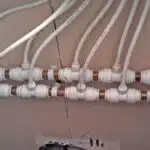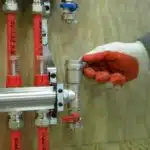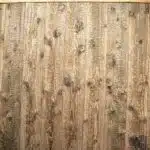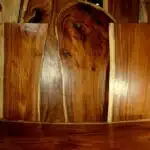Bending wood is a fundamental skill for any woodworking enthusiast. It allows them to create unique and intricate designs that would otherwise be impossible with straight pieces of lumber. However, many people are intimidated by the idea of bending wood at home, assuming that it requires specialized equipment and advanced skills. In reality, with a few basic tools and techniques, anyone can learn how to bend wood at home.
In this article, we will explore the various methods for bending wood, including steam bending, laminating, and kerf bending. We will also discuss the pros and cons of each method and provide step-by-step instructions for beginners. Whether you are looking to build a curved chair back or a circular tabletop, this article will give you all the information you need to bend wood like a pro from the comfort of your own home. So grab your tools and let’s get started!
Understanding The Basics Of Wood Bending
Before embarking on a wood bending project, it is essential to understand the basics of wood grain and how moisture content plays an integral role in successful wood bending. Wood grain refers to the pattern or direction in which the wood fibers run. Understanding wood grain is crucial because it determines how well the wood can bend without cracking or breaking. The two types of wood grain are long and short grain, with long-grain being more flexible and suitable for bending.
Moisture content is another critical factor to consider when bending wood. Moisture changes cause wood to expand or contract, which affects its ability to bend successfully without breaking or cracking. Therefore, it is essential to have proper moisture content before starting any woodworking project. The recommended moisture level for successful bending should be between 25-30%, depending on the type of wood being used.
Temperature, humidity, and pressure are factors that affect wood’s ability to bend successfully. High temperatures make the wood more pliable, while low temperatures make it brittle and prone to breaking. Similarly, high humidity can make the wood more flexible while low humidity makes it rigid and brittle. Pressure also influences how much a piece of wood can bend without breaking; too much pressure can cause deformation or breakage.
When considering all these factors – understanding wood grain, moisture content, temperature, humidity, and pressure – choosing the right type of wood for the job becomes critical for success in your woodworking project. In the next section, we will discuss various types of woods that are suitable for different projects based on their flexibility and strength properties.
Choosing The Right Type Of Wood For The Job
When choosing the right type of wood for the job, it is important to consider the hardness, grain, and weight of the wood.
Hardwoods, such as oak, maple, and walnut, are denser and more durable than softwoods, such as pine, cedar, and poplar.
The hardness of the wood will determine its resistance to wear and tear, and its ability to hold fasteners and withstand the shock of daily use.
The grain of the wood also affects its strength, stiffness, and appearance.
Wood with a straight grain is generally stronger and stiffer than wood with a cross grain.
When bending wood, the grain of the wood should be taken into consideration in order to minimize the risk of cracking or splitting.
Types Of Wood
When it comes to bending wood, choosing the right type of wood is crucial. In this regard, it’s important to consider the comparison and selection of different types of wood based on their unique characteristics and properties. The two main types of wood used for bending are hardwoods and softwoods.
Hardwoods are known for their durability and strength, making them ideal for furniture-making and construction. However, they can be more difficult to bend due to their density. Common hardwoods used for bending include oak, ash, and maple. On the other hand, softwoods are easier to bend due to their lower density but may not be as durable as hardwoods. Pine, cedar, and fir are some common types of softwoods used in woodworking.
It’s also important to note that each type of wood has its own unique characteristics and properties that make them suitable or unsuitable for different projects. For example, some woods may have a tendency to split or crack when bent too sharply while others may be prone to warping or shrinking over time. Therefore, it’s essential to carefully consider these factors when selecting the right type of wood for your project.
In conclusion, choosing the right type of wood is critical when it comes to bending wood at home. By comparing and selecting different types of woods based on their specific characteristics and properties, you can ensure that your project will be successful in terms of both aesthetics and functionality.
Hardness Of Wood
When it comes to woodworking, selecting the right type of wood is a crucial step in achieving a successful project. One factor that must be considered in choosing the right type of wood is its hardness. Wood hardness can have an impact on the bending process, and this should be taken into account when choosing the right type of wood for your project.
Hardness is defined as a measure of a wood’s resistance to indentation or scratching. Hardwood species are typically denser than softwood species, which makes them more difficult to bend. However, some hardwoods like oak, ash, and maple can still be used for bending due to their durability and strength. Softwoods like pine, cedar, and fir are generally easier to bend because they are less dense than hardwoods.
While hardwoods may provide greater strength and durability compared to softwoods, this does not necessarily mean that they are always the better choice for bending projects. Factors such as flexibility and ease of bending must also be considered when selecting the right type of wood for your project. In general, woods that are less dense or have higher moisture content tend to be easier to bend. Ultimately, the choice of which type of wood to use for your project will depend on your specific needs and requirements.
Grain Of Wood
When it comes to woodworking, choosing the right type of wood is crucial for achieving a successful project. While the hardness of the wood is an essential factor to consider, grain orientation is also a critical aspect that must not be overlooked. The grain orientation refers to the direction of the wood fibers and has a significant impact on its strength and flexibility.
The two types of grain orientation are straight grain and cross-grain. Straight grain occurs when the fibers run parallel to each other, while cross-grain happens when they intersect at various angles. Generally, woods with straight grains are stronger than those with cross-grains because they offer more stability and less likelihood of splitting or warping. Cross-grained woods tend to be more flexible and easier to bend since their fibers can move around each other better.
Another factor that affects the wood’s bending ability is its moisture content. Woods with higher moisture content are generally easier to bend since they are more pliable than dry woods. However, excessive moisture can cause the wood to become brittle and prone to cracking or splitting during bending. Therefore, it is essential to balance the moisture content by storing the wood in a controlled environment before use.
In summary, choosing the right type of wood for bending projects involves considering factors such as hardness, grain orientation, and moisture content. Straight-grained woods are generally stronger but less flexible than cross-grained ones. Woods with higher moisture content are easier to bend but require proper storage beforehand. By taking all these factors into account, woodworking enthusiasts can select a suitable type of wood for their projects that will provide excellent results without sacrificing durability or flexibility.
Preparing Your Wood For Bending
Before bending wood, it is important to prepare the wood properly. One of the most crucial factors to consider is the moisture content of the wood. If the wood is too dry, it will likely crack or break during the bending process. On the other hand, if the wood is too wet, it may not hold its shape once bent. To ensure a successful bend, aim for a moisture content of around 20-25%.
Another important factor to consider when preparing your wood for bending is the direction of the grain. When bending wood, you always want to bend across or perpendicular to the grain rather than with it. This helps prevent cracking and allows for a more uniform bend. If you are unsure about which direction your grain runs in, look closely at your piece of wood and observe where there are lines or striations running parallel along its surface.
To achieve optimal results when bending your wood, keep these tips in mind:
- Soak your wood in water overnight before attempting to bend it
- Use a steam box or iron to apply heat and moisture during the bending process
- Use clamps or weights to hold your bent piece in place while it dries
- Sand any rough edges or areas after your piece has fully dried
With these tips in mind, you’ll be able to properly prepare your wood for bending and increase your chances of success in achieving a beautifully curved piece. In the next section, we’ll discuss some essential tools that you’ll need for this woodworking technique.
Tools You’ll Need For Wood Bending
When wood bending, a heat source is necessary to soften the wood and allow it to take shape. The shape of the bend is usually determined by a bending form which is clamped to the wood. Different types of wood can be used, however softwoods tend to work better than hardwoods. It is important to wear protective gloves, an apron and goggles when working with the heat source. A hammer and chisel may be needed to shape the wood further, while sandpaper, saw and file can be used to create a smooth finish. Finally, a safety mask and sealant or glue should be used to finish the piece.
Heat Source
When it comes to bending wood, choosing the right heat source is crucial. There are different heat sources available for this process, each with its own advantages and disadvantages. Some of the most common heat sources include hot water, steam, and electric heating blankets.
Hot water is a popular choice for wood bending because it is easily accessible and inexpensive. This method involves soaking the wood in hot water until it becomes pliable enough to bend. However, it can be difficult to control the temperature of the water, which can lead to over-soaking or scorching of the wood. Safety precautions must also be taken when handling hot water.
Steam bending is another option that involves exposing the wood to steam in order to soften it before bending. This method requires specialized equipment such as a steam box or a PVC pipe system. While more complex than using hot water, steam bending allows for greater control over temperature and time of exposure. As with any heat source, safety precautions must be taken when dealing with hot steam.
Regardless of which heat source you choose for your wood bending project, safety should always be a top priority. Always wear protective gear such as gloves and eye protection when handling heated materials, and make sure to follow all recommended safety precautions for your chosen heat source. By taking these steps, you can ensure a successful and safe wood bending experience without risking injury or damage to your materials.
Bending Form
When it comes to wood bending, using the right tools is crucial for achieving the desired results. In addition to choosing the right heat source, selecting the appropriate bending form is also important. Bending form refers to the shaping techniques and materials used to achieve a specific bend or curve in the wood.
The most common types of bending forms include simple jigs, laminated forms, and vacuum bags. Simple jigs are often made from scrap wood and can be easily customized for different projects. Laminated forms involve layering thin strips of wood together to create a curved shape that can be clamped onto the workpiece. Vacuum bags use suction to compress layers of wood around a mold or form, creating a smooth and even bend. Each type of bending form has its own advantages and disadvantages depending on the project at hand.
Regardless of which type of bending form you choose, it’s important to have a clear plan in place before beginning any shaping techniques. This includes carefully measuring and marking where bends will occur, as well as selecting appropriate clamps or fasteners to hold everything in place during the bending process. By taking these steps and using the right tools for your project, you can create beautiful and functional bent wood pieces that are sure to impress.
Clamps
When it comes to wood bending, using the right tools is crucial for achieving the desired results. And among these essential tools are clamps. Clamps come in different types and sizes, and choosing the right one can make a significant difference in the outcome of your project. Some clamp types that you may find useful when bending wood include bar clamps, pipe clamps, C-clamps, and spring clamps.
When placing clamps during wood bending, it’s important to consider the type of bend you’re creating and how much pressure is needed. For bends that require a lot of pressure, such as tight curves or twists, you’ll need to use more clamps and place them closer together. On the other hand, for bends with gentler curves or less resistance, fewer clamps can be used.
Another factor to keep in mind when placing clamps is to avoid applying too much pressure on any one area of the workpiece. Doing so may cause unwanted warping or damage to the wood fibers. Instead, place the clamps evenly along the entire length of the workpiece to distribute pressure evenly. By doing this and selecting appropriate clamp types for your project, you can achieve successful wood bending results with ease.
Steam Bending: The Basics
When it comes to bending wood, steam bending is a popular technique that has been used for centuries. This method involves applying heat and moisture to the wood, making it pliable enough to bend into the desired shape. One of the most important tools in this process is a bending strap, which helps hold the wood in place as it cools and sets into its new shape.
Before beginning the steam bending process, there are a few tips to keep in mind. First, choose a hardwood species that is known for its flexibility and workability, such as ash or oak. Next, make sure your steaming setup is safe and secure – hot steam can be dangerous if not handled properly. Finally, be patient and take your time with each bend – rushing can lead to mistakes or even injury.
To further emphasize the importance of patience and attention to detail during the steam bending process, consider this table:
| Common Mistakes | Consequences | How to Avoid |
|---|---|---|
| Rushing through bends | Inaccurate shapes or cracks in wood | Take your time and check progress often |
| Improperly secured strap | Uneven bends or injuries | Ensure strap is tight and secure before steaming |
| Insufficient steaming time | Wood not pliable enough for desired bend | Follow recommended steaming times for chosen species |
Overall, steam bending can be a highly effective method for shaping wood into various forms and designs. However, it requires careful attention to detail and safety precautions throughout the entire process. In the next section, we will explore some of the pros and cons of using steam bending compared to other methods of shaping wood.
Steam Bending: Pros And Cons
Steam bending is a popular technique used in woodworking to create curved or bent pieces of wood. It involves using steam to soften the wood fibers, allowing them to be shaped into curves without breaking. While there are several advantages to steam bending wood at home, there are also some disadvantages that must be considered.
Advantages of Steam Bending:
- Creates unique designs: Steam bending allows for the creation of unique shapes and curves that cannot be achieved with other techniques.
- Cost-effective: Steam bending can be done with basic tools and equipment, making it an affordable option for those on a budget.
- Environmentally friendly: Unlike other techniques that require glue or other chemicals, steam bending does not use any harmful substances.
Disadvantages of Steam Bending:
- Requires skill and practice: Steam bending requires a certain level of skill and experience to ensure that the wood does not crack or break during the process.
- Limited types of wood: Not all types of wood are suitable for steam bending. Only woods with straight grains such as oak, ash, hickory, maple and walnut work well for this technique.
- Time-consuming process: The process can take several hours or even days depending on the thickness and type of wood being bent.
When considering whether or not to try steam bending at home, it is important to weigh both the advantages and disadvantages. While it can be a cost-effective way to create unique designs without using harmful chemicals, it also requires skill, limited types of wood selection, and a significant amount of time. In the next section, we will provide you with a step-by-step guide on how to successfully perform steam bending at home.
Steam Bending: Step-By-Step Guide
Despite its drawbacks, steam bending remains one of the most effective methods for bending wood at home. However, if you do not have access to a steam box or find the process too cumbersome, there are alternative methods to achieve similar results. One such method is using a bending strap.
A bending strap is a flexible metal strap that can be clamped onto the wood and bent into shape using leverage. This method requires less equipment and can be done without the need for a steam box. However, it is important to note that this technique requires some skill and practice to achieve consistent results.
Other alternative methods include laminating thin strips of wood together to create curves or using kerfing techniques where shallow cuts are made on one side of the wood, allowing it to bend more easily. While these alternatives may not produce as smooth curves as steam bending, they offer greater flexibility in terms of design possibilities and can still produce beautiful results.
Moving forward, we will explore another technique for bending wood: laminating. Laminating involves gluing thin layers of wood together to create a stronger and more flexible piece of material. This method is often used in furniture making and offers endless design possibilities while also being relatively easy for beginners to tackle.
Laminating: The Basics
- Selecting the right type of wood is essential when laminating, as the properties of the wood will determine the end result.
- The wood should be prepared prior to laminating by cutting it to the desired size and sanding it to a smooth finish.
- The adhesive should be chosen based on the properties of the wood and the laminating technique employed.
- The adhesive should be applied evenly, making sure to leave no gaps or air pockets.
- The adhesive should be allowed to dry for the recommended amount of time before attempting to bend the wood.
- Care should be taken to ensure that the wood does not split or crack as it is being bent.
Choosing The Wood
If you’re planning to bend wood at home, it’s important you choose the right type of wood that suits your project’s needs. Before deciding on which wood to use, consider the types and properties of the wood available to you. Some woods are naturally more flexible and easier to bend than others, while some may require a bit more effort to get the desired shape.
When it comes to choosing the type of wood to use for your bending project, there are several options available. Firstly, some of the most common types of bending woods include ash, oak, hickory, maple and cherry. These woods are known for their flexibility and durability when it comes to bending. Additionally, hardwoods such as birch and poplar can also be used for bending projects with great results.
Apart from the type of wood, it’s also crucial to consider its properties before making a final decision. The moisture content is one property that can affect how easily a particular type of wood bends. Woods with higher moisture content tend to be more pliable compared to those with lower moisture content. Moreover, grain direction plays an essential role in determining how well a piece of wood will bend. Wood with straight grains tends to be easier to bend compared with those that have interlocking grains.
In summary, selecting the right type of wood is crucial in ensuring successful results when bending wood at home. Understanding the types and properties of different woods available can help you make an informed choice for your specific project requirements. By taking into account factors like moisture content and grain direction when choosing your wood, you can save time and effort in achieving your desired result without compromising on quality or durability.
Preparing The Wood
Before delving into the basics of laminating wood, it’s essential to discuss the crucial step of preparing the wood. Preparing the wood properly can make all the difference in achieving successful results when laminating. One method of preparing wood for lamination is by soaking it in water. Wood soaking is a process that helps make the wood more pliable and easier to bend to the desired shape. It’s important to note that this technique works best with hardwoods such as oak, ash, and maple.
Another method of preparing wood for lamination involves heat treatment. This process helps remove moisture from the wood and makes it more stable and less likely to warp or crack during lamination. Heat treatment can be achieved through several methods, including heating the wood in an oven or using a heat gun. However, caution must be taken not to overheat the wood, as this can cause damage or weaken its structural integrity.
In conclusion, proper preparation of the wood is crucial when laminating to ensure successful results and achieve a durable finished product. Wood soaking and heat treatment are two effective methods that can help make the wood more pliable and stable during lamination. By incorporating these techniques into your woodworking process, you can achieve high-quality results that stand up to wear and tear over time.
Applying The Adhesive
Now that we have discussed the importance of properly preparing the wood, it’s time to move on to the next step in laminating: applying the adhesive. The type of adhesive used will depend on the project and the materials being laminated. Common types of adhesives used for woodworking include epoxy, polyurethane, and cyanoacrylate.
When applying the adhesive, it’s important to follow proper techniques to ensure a strong bond between the layers of wood. One technique is to apply a thin layer of adhesive evenly over each surface that will be laminated together. Another technique is to apply pressure using clamps or weights while the adhesive dries. It’s crucial not to rush this process as giving ample time for drying and setting will result in a more durable finished product.
However, there are common mistakes that should be avoided when applying adhesive during lamination. One mistake is over-applying or under-applying adhesive, which can lead to poor bonding or excess glue seeping out and creating a mess. Another mistake is not properly cleaning and preparing surfaces before applying the adhesive, which can also lead to poor bonding and a weak finished product. By taking care to avoid these mistakes and following proper techniques for applying adhesive, you can achieve successful results in your woodworking projects.
Laminating: Pros And Cons
Laminating is a popular method used to bend wood. This technique involves gluing several thin strips of wood together until they form a larger, thicker piece. The process of lamination creates a more stable and uniform surface that can withstand pressure better than a single piece of wood. In comparison to steam bending, lamination has the advantage of allowing for more complex shapes and curves.
One drawback of laminating is the time it takes to complete the process. Unlike steam bending, which can be done relatively quickly, laminating requires multiple steps and can take several days to complete. Another disadvantage is that it can be difficult to achieve consistent results when gluing together multiple pieces of wood. Any gaps or imperfections in the glue joint can weaken the final product.
There are several techniques for laminating wood, including vacuum bagging, clamping with cauls, or using specialized presses. Each technique has its advantages and disadvantages depending on the specific project requirements and available tools. However, regardless of the method chosen, proper preparation and attention to detail will ensure a successful outcome.
Transition into subsequent section: With an understanding of lamination’s pros and cons, let us now move on to explore a step-by-step guide for laminating wood at home.
Laminating: Step-By-Step Guide
Laminating is a process of bonding two or more thin layers of wood together to create a thicker and stronger board. It is commonly used in woodworking to create curved shapes that cannot be achieved by bending solid wood. Laminating can be used for both simple and complex curves, making it a versatile technique for woodworking projects.
Types of adhesives for laminating:
- Resorcinol glue: This waterproof adhesive is ideal for outdoor projects as it can withstand extreme weather conditions.
- Polyurethane glue: This glue dries clear and is ideal for laminating projects where an invisible bond line is desired.
- Epoxy glue: This adhesive creates a strong bond and is best suited for laminating large surfaces.
- PVA glue: This water-based adhesive is easy to work with and dries clear. It is best suited for laminating small surfaces.
Using laminating for complex curves requires careful planning and preparation. Before starting the project, it’s important to create a template of the desired curve using a flexible material such as MDF or thin plywood. The template should be slightly larger than the final product to allow for sanding and shaping.
Once the template is ready, cut the wood into thin strips using a table saw or band saw. Apply adhesive evenly on each strip and lay them on top of each other, aligning the grain patterns if possible. Clamp the strips together tightly, making sure there are no gaps between them. Allow the adhesive to dry completely before removing the clamps and sanding down any imperfections.
Incorporating laminating into your woodworking projects can add an extra dimension of creativity and design possibilities. With proper preparation and the right types of adhesives, you can achieve beautiful curved shapes that would otherwise be impossible with solid wood alone.
Transition sentence into subsequent section about kerf bending: Kerf bending offers another solution for creating curved shapes in woodworking.
Kerf Bending: The Basics
Kerf bending is a woodworking technique which involves cutting a series of slits into wood, allowing it to be bent into shape. To execute a successful kerf bend, the right tools and materials are essential. Common tools used for kerf bending include saws, clamps, heat guns, and sandpaper. Softwoods are typically the best type of wood for kerf bending due to their flexibility and ability to hold a bent shape.
Tools Needed
When it comes to Kerf bending, the right tools are crucial. Sourcing materials is the first step in any woodworking project, and for Kerf bending, you’ll need a table saw with a kerf blade. These blades have teeth that are wider than standard blades, which allows them to make wider cuts in the wood. Additionally, you’ll need a strip heater or heat gun to soften the wood fibers so that they can be bent without breaking.
Safety precautions should always be taken when working with any power tool. When using a table saw, wear eye protection and keep your fingers well clear of the blade. If you’re using a heat gun or strip heater, be sure to work in a well-ventilated area and protect your hands from burns by wearing thick gloves. Always read the manufacturer’s instructions before using any new equipment.
In conclusion, sourcing the necessary tools and taking safety precautions is essential for successful Kerf bending at home. A table saw with a kerf blade and a strip heater or heat gun will help you achieve smooth bends in your wood projects while keeping your fingers safe from harm. Remember to always prioritize safety when working with power tools and follow all manufacturer instructions carefully.
Types Of Wood
When it comes to wood bending techniques, the type of wood you use will greatly affect the success of your project. Some woods are more suitable for bending than others, with characteristics such as flexibility and durability playing a significant role in determining their suitability. The best wood for bending is one that is both flexible and strong enough to withstand the bend without breaking.
One popular choice for Kerf bending is Baltic Birch plywood, which has several layers of thin wood glued together, making it strong and flexible. Another option is White Oak, a hardwood that has excellent bending properties due to its high tannin content. Other types of wood that can be used for Kerf bending include Red Oak, Walnut, Maple, and Cherry.
It’s important to remember that different types of wood will require different heat settings and pressure levels when using Kerf bending techniques. Experimenting with different woods and understanding their properties will help you achieve successful bends in your woodworking projects. By selecting the best wood for bending and utilizing proper techniques with your tools, you’ll be able to create beautiful pieces that showcase your craftsmanship and creativity.
Kerf Bending: Pros And Cons
So, you’ve tried your hand at kerf bending and now you’re wondering if it’s worth all the effort. Well, let’s take a look at the pros and cons of this technique.
Kerf bending does have its advantages. It’s a fairly simple technique that can be done at home with basic tools. Plus, it allows for some creative designs that might not be possible with other bending methods. However, there are also some downsides to consider.
One of the biggest drawbacks of kerf bending is that it requires a lot of trial and error to get right. You’ll need to experiment with different widths and depths of cuts to achieve the desired bend without breaking the wood. Additionally, this method is not suitable for all types of wood and may not work well with thicker pieces or certain grain patterns. If you’re looking for an alternative to kerf bending, there are other techniques such as laminating thin strips together or using steam bending that may better suit your needs.
Transition: While kerf bending certainly has its benefits, it may not always be the best option for every project. If you do decide to give it a try, here’s what you need to know about the step-by-step process.
Kerf Bending: Step-By-Step Guide
Kerf bending is a popular method used to bend wood without the use of steam or heat. It involves making multiple cuts in the wood, creating small slits known as kerfs, which allow the wood to be more pliable and flexible. This technique has been around for years and can be done with simple tools that are readily available at home.
Types of cuts for kerf bending include saw kerfs, router kerfs, and band saw kerfs. Saw kerfs are the simplest and most common method used by woodworkers. Router kerfs are made using a router with a straight bit while band saw kerfs are usually used for thicker pieces of wood. Different kerf bending designs can also be achieved by varying the spacing between each cut or by using different thicknesses of wood.
To begin, mark where you want your bend to occur on the piece of wood. Then, make several evenly spaced cuts along this line using your chosen cutting tool. Be sure not to cut all the way through the wood as this will weaken its structural integrity. Once all cuts have been made, gently apply pressure to bend the wood in the desired direction. Keep in mind that some types of woods may require more or less pressure than others and it may take several attempts before achieving your desired result.
In summary, mastering the art of kerf bending is an essential skill for any woodworking enthusiast looking to create unique designs without relying on heat or steam methods. With various types of cuts available and different design possibilities achievable, there is no limit to what you can create with this technique. Next up we will explore tips and tricks for successful wood bending without requiring professional equipment or complicated methods.
Tips And Tricks For Successful Wood Bending
Bending wood is a challenging task that requires a certain level of expertise. However, with the right tools and techniques, you can successfully bend wood at home. To achieve this, it is essential to follow certain tips and tricks that will help prevent wood from cracking during the bending process.
One of the best ways to avoid wood cracking while bending is to use steam. This method involves exposing the wood to high-temperature steam, which makes it more pliable and easier to bend. Additionally, applying pressure using clamps or straps can also help prevent cracking. When applying pressure, it is important to do so gradually, as too much pressure can cause the wood to break.
Another tip for successful wood bending is to choose the right type of wood for your project. Certain woods are more suitable for bending than others due to their natural flexibility and grain patterns. Some popular options include oak, ash, and hickory. Additionally, proper preparation before bending can also help prevent cracks. This includes soaking the wood in water or using a conditioning solution before applying heat or steam.
| Pressure Method | Advantages | Disadvantages |
|---|---|---|
| Using Clamps | Provides uniform pressure | Can leave marks on surface |
| Strapping Method | Can be used on irregular surfaces | Requires more effort |
| Vacuum Bagging Method | Provides even distribution of pressure | Requires special equipment |
To successfully bend wood at home, it is important to follow these tips and tricks while selecting the appropriate method for your project needs. Remember that patience and attention-to-detail are crucial when working with such materials.
As you continue on your journey towards mastering woodworking skills at home, it’s important not only learn what works but also understand common mistakes that need avoiding when bending wood at home. In doing so, you’ll be better equipped with knowledge needed for effectively creating handcrafted projects that meet your needs perfectly without wasting any resources along the way.
Common Mistakes To Avoid When Bending Wood At Home
Successful wood bending requires careful planning, attention to detail, and patience. Even with the best tips and tricks, however, there are common mistakes that many people make when attempting to bend wood at home. Avoiding these mistakes can save time, money, and frustration in your woodworking projects.
One of the most common mistakes is failing to properly prepare the wood before attempting to bend it. Wood needs to be soaked or steamed for a period of time to make it more pliable and easier to bend. Skipping this step or not soaking the wood for long enough can result in cracking or breaking during the bending process.
Another mistake is trying to bend wood that is too thick or too wide. Thicker pieces of wood require more time and heat to become pliable, which can increase the risk of cracking or breaking. Similarly, wider pieces of wood may be more difficult to bend evenly without causing stress points that can lead to cracks or breaks. It is important to choose the right thickness and width of wood for your project and follow proper bending techniques.
By avoiding these common mistakes and following the tips and tricks for successful wood bending, you can achieve beautiful results in your woodworking projects. Remember to take your time, carefully prepare your materials, choose the right thickness and width of wood, and follow proper bending techniques. With practice and patience, you can master this essential woodworking skill and create stunning pieces that will last a lifetime.
Conclusion
Woodworking enthusiasts who are looking to add a unique touch to their projects may find themselves interested in the art of wood bending. While it can be challenging, this technique is not impossible to master with the right knowledge and tools at your disposal.
To begin, it is crucial to understand the basics of wood bending and choose the right type of wood for the job. Proper preparation techniques must also be followed, such as soaking or steaming the wood before bending it. A range of tools is required for successful wood bending, including clamps, forms, and saws.
Steam bending is a popular method that involves exposing the wood to high temperatures and humidity levels before shaping it. Another technique known as kerf bending can also be used but requires careful attention to detail during cutting and shaping.
As with any woodworking project, there are common mistakes to avoid when attempting to bend wood at home. However, with patience and practice, anyone can learn how to create beautiful curves and angles in their wooden creations.
In conclusion, mastering the art of wood bending requires dedication and attention to detail. While challenging, this technique can add a unique touch to your woodworking projects that cannot be achieved through traditional methods. With careful preparation and execution, anyone can successfully bend wood at home.
Image Credits
- “Concrete Wood Patio with furniture – Innovative Spaces – South Bend IN” by Decorative Concrete Kingdom (featured)












![How To Repair Rotted Wood 12 Texture : Altario Buick Estate Wagon : Rotting Faux Wood Paneling [1 of 2]](https://green-life.blog/wp-content/uploads/2023/05/z1CersK-gCjq-150x150.jpg.webp)
















